Input interpretation

hexachloroethane
Chemical names and formulas
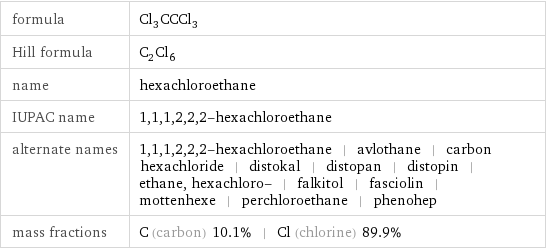
formula | Cl_3CCCl_3 Hill formula | C_2Cl_6 name | hexachloroethane IUPAC name | 1, 1, 1, 2, 2, 2-hexachloroethane alternate names | 1, 1, 1, 2, 2, 2-hexachloroethane | avlothane | carbon hexachloride | distokal | distopan | distopin | ethane, hexachloro- | falkitol | fasciolin | mottenhexe | perchloroethane | phenohep mass fractions | C (carbon) 10.1% | Cl (chlorine) 89.9%
Lewis structure
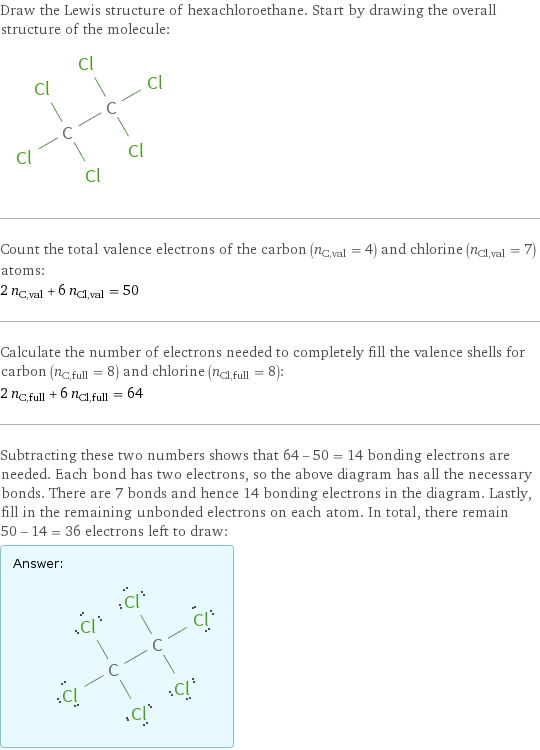
Draw the Lewis structure of hexachloroethane. Start by drawing the overall structure of the molecule: Count the total valence electrons of the carbon (n_C, val = 4) and chlorine (n_Cl, val = 7) atoms: 2 n_C, val + 6 n_Cl, val = 50 Calculate the number of electrons needed to completely fill the valence shells for carbon (n_C, full = 8) and chlorine (n_Cl, full = 8): 2 n_C, full + 6 n_Cl, full = 64 Subtracting these two numbers shows that 64 - 50 = 14 bonding electrons are needed. Each bond has two electrons, so the above diagram has all the necessary bonds. There are 7 bonds and hence 14 bonding electrons in the diagram. Lastly, fill in the remaining unbonded electrons on each atom. In total, there remain 50 - 14 = 36 electrons left to draw: Answer: | |
3D structure
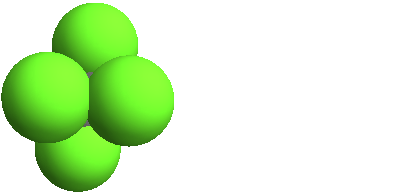
3D structure
Basic properties
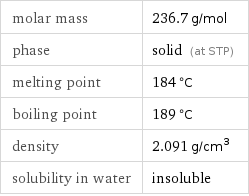
molar mass | 236.7 g/mol phase | solid (at STP) melting point | 184 °C boiling point | 189 °C density | 2.091 g/cm^3 solubility in water | insoluble
Units

Solid properties (at STP)

density | 2.091 g/cm^3 vapor pressure | 0.3999 mmHg
Units

Thermodynamic properties

specific heat capacity c_p | solid | 0.8373 J/(g K) molar heat capacity c_p | solid | 198.2 J/(mol K) specific heat of formation Δ_fH° | gas | -6.066 kJ/g molar heat of formation Δ_fH° | gas | -1436 kJ/mol molar heat of vaporization | 40.6 kJ/mol | specific heat of vaporization | 0.172 kJ/g | molar heat of combustion | 461 kJ/mol | specific heat of combustion | 1.95 kJ/g | molar heat of fusion | 9.75 kJ/mol | specific heat of fusion | 0.0412 kJ/g | (at STP)
Chemical identifiers
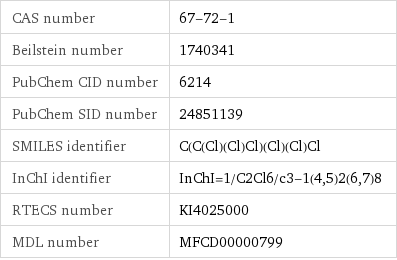
CAS number | 67-72-1 Beilstein number | 1740341 PubChem CID number | 6214 PubChem SID number | 24851139 SMILES identifier | C(C(Cl)(Cl)Cl)(Cl)(Cl)Cl InChI identifier | InChI=1/C2Cl6/c3-1(4, 5)2(6, 7)8 RTECS number | KI4025000 MDL number | MFCD00000799
NFPA label

NFPA label

NFPA health rating | 2
Safety properties

flash point | 61 °C

DOT hazard class | 6.1 DOT numbers | 9037
Toxicity properties

RTECS classes | agricultural chemical and pesticide | tumorigen | drug | mutagen | reproductive effector